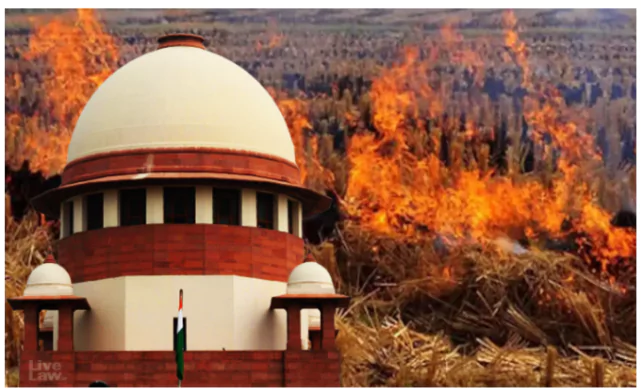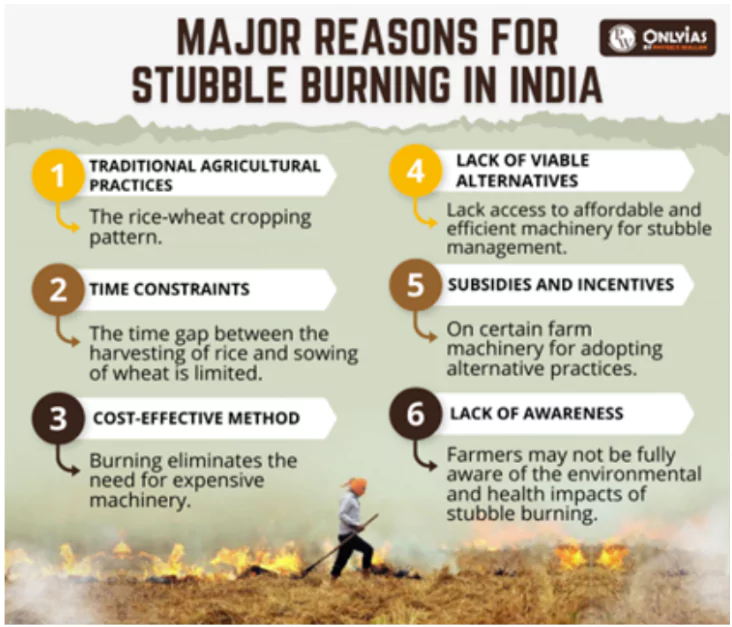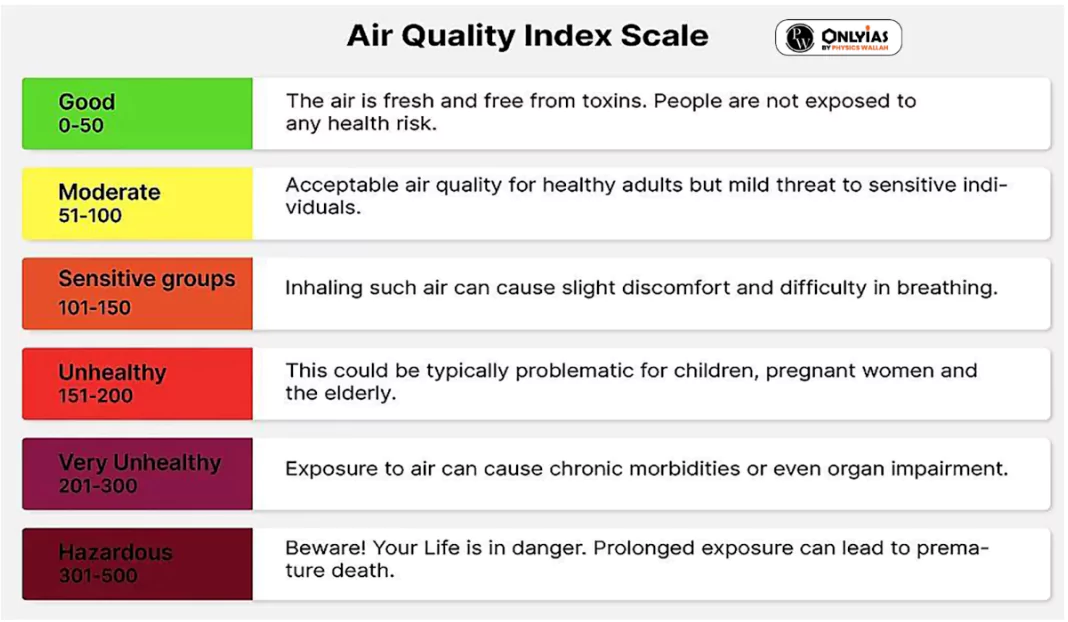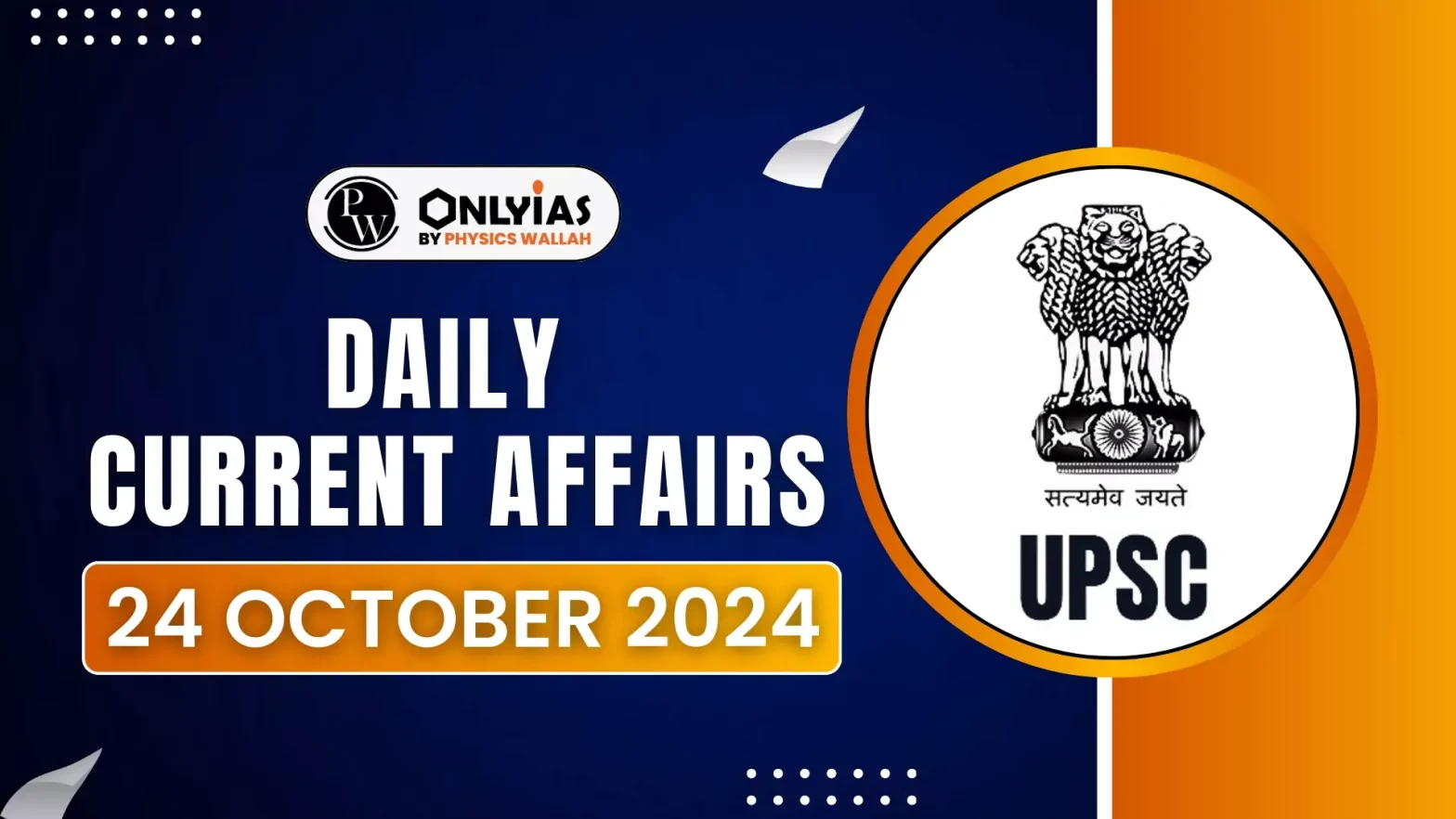Recently, the Supreme Court said continuing cases of stubble-burning and the “pick-and-choose” policy adopted by the Punjab and Haryana governments to penalise a few while letting many violators go “scot-free” after paying a nominal fine violated citizens’ right to live in a pollution-free environment.
Stubble burning in Punjab and Haryana
- Stubble burning in Punjab and Haryana is a significant contributor to air pollution in Northern India, particularly in and around Delhi.
- The Supreme Court criticised both states for their lack of effective action in curbing stubble burning and prosecuting violators.
Enroll now for UPSC Online Course
Stubble Burning Violates Article 21: SC

- Defiance by States:
- The court accused Punjab and Haryana of showing a “defiant attitude” by not taking penal action against offenders.
- Haryana claimed they couldn’t detect fires despite information from ISRO pinpointing the exact locations.
- Punjab prosecuted only a handful of violators, out of over 1,000 incidents detected.
- Lax Enforcement:
- A nominal fine system allowed violators to escape serious penalties, undermining deterrence.
- Penal provisions under Section 15 of the Environment (Protection) Act, 1986, which include imprisonment and heavy fines, were not consistently enforced.
- Violation of Fundamental Rights:
- The court said stubble burning is not merely an issue of breach of law but it constitutes violation of citizens’ fundamental right to live in a pollution-free environment, guaranteed under Article 21 of the Constitution (Right to Life).
About Commission for Air Quality Management
- It is a Statutory body formed under the Commission for Air Quality Management in National Capital Region and Adjoining Areas, Act 2021.
- Composition:
- It has a Chairperson
- 5 ex-officio members (Chief Secretaries or Secretaries in charge of the department dealing with environment protection in Delhi, Punjab, Haryana, Rajasthan, and Uttar Pradesh.)
- 3 full time technical members;
- 3 members from non-government organisations; Technical members from CPCB, Indian Space Research Organisation, and NITI Aayog
- Objectives:
- Air pollution control: The CAQM’s main goal is to prevent, monitor, and control air pollution in the NCR.
- Research and development: The CAQM conducts research and development to identify air pollutants and improve air quality.
|
-
- It criticised the failure of the authorities to protect this fundamental right.
- Commission for Air Quality Management (CAQM):
- The court questioned the effectiveness of CAQM, noting absenteeism among its members and doubts over their expertise in air pollution management.
- Government Accountability:
- The court directed the Union government to:
- Formulate proper machinery for penal action under the Environment Act.
- Consider Punjab’s request for additional funds to tackle the issue.
- Address urban air pollution, especially in Delhi, where garbage burning adds to air toxicity.
Check Out UPSC CSE Books From PW Store
Article 21 of the Constitution
- Protection of life and personal liberty: No person shall be deprived of his life or personal liberty except according to procedure established by law.
- This means that every individual has the right to live, and their life cannot be taken away except in accordance with the prescribed legal procedures.
- The right to life encompasses various aspects, including the right to live with dignity, the right to livelihood, and the right to a healthy environment.
- It also states that no person shall be deprived of their personal liberty except according to the procedure established by law.
- Personal liberty includes the freedom to move freely, the freedom to choose one’s place of residence, and the freedom to engage in any lawful occupation or profession.
- This right is available to both citizens and non-citizens.

|
Constitutional Status to the Environment Protection
- Indian Constitution the first in the world conferring constitutional status to the environment protection.
- Constitutional (forty-second Amendment) Act, 1976 incorporated two significant articles viz. Article 48-A and 51A (g)
- Article 48-A: State shall endeavour to protect and improve the environment and to safeguard the forests and wildlife of the country.
- Article 51A(g): It is a duty of every citizen to protect and preserve the environment.
Important Judgement of SC related to Right to Clean Environment
- Rural Litigation and Entitlement Kendra vs. State (1988): Recognised the right to live in a healthy environment as part of Article 21 of the Constitution.
- M.C. Mehta vs. Union of India (1987): Treated the right to live in a pollution free environment as a part of fundamental right to life under Article 21 of the Constitution.
- Virender Gaur v. State of Haryana (1994): Recognition that the right to a clean environment is an integral facet of the right to a healthy life.
- M K Ranjitsinh & Ors. v. Union of India & Ors.(2024): Supreme Court ruled that that people have a right to be free from the adverse effects of climate change under Article 14 and Article 21
- Article 14 (Right to Equality) would also be violated as climate change will affect some people more than others.
|
About Stubble Burning
- It is a practice of removing agricultural waste from the field by setting on fire the straw stubble (Parali) that is left on the land after harvesting of grains like paddy, wheat etc.
 It is mostly practised in the Indo-Gangetic plains of Punjab, Haryana, and Uttar Pradesh to clear the fields for rabi crop sowing in October and November.
It is mostly practised in the Indo-Gangetic plains of Punjab, Haryana, and Uttar Pradesh to clear the fields for rabi crop sowing in October and November.
Challenges Associated With Stubble Burning
- Air Pollution: Each year, air pollution levels rise and the AQI reaches a ‘severe’ and ‘hazardous’ level.
- Harmful Health Impacts: It emits toxic pollutants in the atmosphere containing harmful gases like Carbon Monoxide (CO), methane (CH4), NH3, SO2, carcinogenic polycyclic aromatic hydrocarbons, and volatile organic compounds (VOC).
- Heat Penetration: Heat generated by stubble burning penetrates into the soil, leading to the loss of moisture and useful microbes
- For instance, the heat from burning paddy straw penetrates 1 centimetre into the soil, elevating the temperature to around 400 Celsius.
- Soil Fertility: Burning husk on the ground destroys the nutrients in the soil, making it less fertile.
- Global Warming: Greenhouse gases such as CO2, N2O, O3,etc are released during Stubble burning.

Ways to Eliminate Stubble Burning
In-Situ Management (On-Field Management)
- Utilising specialised machinery or bio-chemicals to manage crop residue directly on the field, reducing the need for burning.
- Pusa Decomposer: A microbial solution developed by the Indian Agricultural Research Institute (IARI) that breaks down stubble into manure, enhancing soil fertility.
- Happy Seeder: A machine that cuts and lifts paddy straw, sows wheat, and spreads the straw as mulch.
Check Out UPSC NCERT Textbooks From PW Store
Ex-Situ Management (Off-Field Management)
- Transporting crop residue to other locations for alternative uses such as:
- Composting: Converting stubble into organic compost.
- Biogas Production: Using crop residue as feedstock for biogas plants.
- Biochar: Converting stubble into biochar for soil improvement.
- Palletization: It is a technique that involves turning rice straw into usable boards for packaging, furniture, and other purposes.
- Co-Firing in Thermal Plants: Paddy straw is converted into pellets and used as fuel in thermal power plants, reducing dependence on coal.
Promotion of Alternative Crops
- Encouraging farmers to shift to crop varieties or farming systems that require less stubble removal.
- Promoting short-duration paddy varieties, pulses, oilseeds, or horticulture crops.
Create Table………
National Policy for Management of Crop Residue (NPMCR)
- It was formulated in 2014 by the Ministry of Agriculture and Farmers Welfare
- Objective: To prevent the burning of crop residue and the resulting environmental degradation and loss of soil nutrients.
- The policy aims to achieve this by:
- Promoting in-situ management: This includes incorporating crop residue into the soil, mulching, and baling or binding it for use as fuel or fodder.
- Diversifying uses: Crop residue can be used for a variety of purposes, including charcoal gasification, power generation, and as a raw material for bio-ethanol, paper, and packing materials.
- Raising awareness: Stakeholders should be educated about the negative effects of burning crop residue and how to manage and use it effectively.
- Using satellite-based remote sensing: The National Remote Sensing Agency (NRSA) and Central Pollution Control Board (CPCB) can use satellite-based remote sensing to monitor crop residue management.
- Providing financial support: Ministries can provide financial support for innovative ideas and projects to help achieve the policy’s goals.
|
Techno-Commercial Pilot Projects
- Supply Chain Development: Establishing supply chains between farmers and industries for the sustainable utilisation of crop residue.
- Financial Assistance:
- Government support covering up to 65% of machinery and equipment costs for stubble management.
- Working Capital: Joint funding by the industry and beneficiaries, or through mechanisms like Agriculture Infrastructure Fund (AIF) and NABARD.
- Land Arrangements: Farmers responsible for securing and preparing storage land for residue management.
Check Out UPSC Modules From PW Store
Policy Support
- Revised Crop Residue Management Guidelines: Issued by the Central Government to promote both in-situ and ex-situ management in states like Punjab, Haryana, Uttar Pradesh, and Delhi.
- National Policy for Management of Crop Residues (NPMCR): This policy aims to prevent the burning of crop residue and the resulting environmental degradation and loss of soil nutrients.
- Financial Incentives:
- Project-Based Support: Financial assistance for specific machinery and equipment under government schemes.
- State Government Approval: Projects must be approved by Project Sanctioning Committees.
- Convert into Organic Fertiliser: From parali, we can obtain high-grade organic fertiliser.
- In Chhattisgarh, undertaken innovative experiment by setting up gauthans.
- A gauthan is a dedicated five-acre plot, held in common by each village, where all the unused parali (pairain Chhattisgarhi) is collected through parali daan (people’s donations) and is converted into organic fertiliser by rural youth.
- the government supports only the transportation of parali from the farm to the nearest gauthan.
- Industry Contribution: Industry contributes 25% of the project cost.
- Farmer or Group Contribution: Farmers or groups contribute 10% of the project cost.
Other Measures
- Farmer Education and Awareness Campaigns: Increasing awareness about the adverse effects of stubble burning and the benefits of alternative methods.
- Custom Hiring Centres (CHCs): Providing easy access to machinery for crop residue management through CHCs.
- Subsidies and Incentives for Machinery: Offering subsidies for equipment like Happy Seeders, rotavators, and mulchers to reduce the cost burden on farmers.
Challenges in Eliminating Stubble Burning
- High Cost of Machinery: Farmers face significant financial constraints in purchasing or renting machinery like Happy Seeders and Super Straw Management Systems, even with subsidies.
- Smaller and marginal farmers, in particular, struggle to afford these technologies.
- Short Window Between Crops: The narrow time gap (10-15 days) between the harvesting of paddy and sowing of wheat leaves little time for alternative stubble management methods.
- Leading farmers to opt for the quicker and cheaper method of burning.
- Lack of Awareness and Training: Many farmers are unaware of the long-term environmental impacts of stubble burning and the benefits of sustainable alternatives.
- There is also limited training on the use of new technologies for in-situ and ex-situ management.
- Weak Enforcement of Laws: Existing laws, such as penal provisions under the Environment (Protection) Act, 1986, are poorly enforced.
- Nominal fines and lack of consistent prosecution do not act as a sufficient deterrent to prevent stubble burning.
- Limited Infrastructure for Ex-Situ Management: Supply chains, storage facilities, and infrastructure for transporting crop residue to industries for alternative uses (e.g., biofuel, composting) are underdeveloped, limiting the scope of ex-situ management.
- Socio-Economic Pressures: Farmers face economic pressure to maximise yields and profits.
- Often leading them to choose the most cost-effective and time-efficient methods like burning, especially when incentives for sustainable alternatives are insufficient or delayed.
- Social Resistance: Some farmers may resist adopting new practices due to traditional farming methods and cultural beliefs.
Way Forward
- Strengthening Farmer Incentive Programs: Provide direct financial incentives to farmers for adopting eco-friendly alternatives, ensuring that support reaches marginal and small farmers quickly.
- Improved Policy Coordination: Ensure better coordination between Central and State governments on stubble management policies.
- Research and Development (R&D) in Affordable Technologies: Invest in R&D to develop low-cost, accessible technologies that small farmers can afford.
- Expanding Custom Hiring Centers (CHCs): Scale up Custom Hiring Centers to improve the availability of crop residue management machinery on rent.
- Community-Based Initiatives and Farmer Cooperatives: Promote community-led solutions by organising farmers into cooperatives or groups that can collectively manage crop residue.
Enroll now for UPSC Online Classes
Conclusion
- The Supreme Court criticised the Haryana and Punjab governments for their lenient approach toward stubble burning, which worsens air pollution in northern India.
- It emphasised the need for stricter enforcement of laws to protect citizens’ right to a pollution-free environment under Article 21 of the Constitution.
![]() 24 Oct 2024
24 Oct 2024


 It is mostly practised in the Indo-Gangetic plains of Punjab, Haryana, and Uttar Pradesh to clear the fields for rabi crop sowing in October and November.
It is mostly practised in the Indo-Gangetic plains of Punjab, Haryana, and Uttar Pradesh to clear the fields for rabi crop sowing in October and November.
